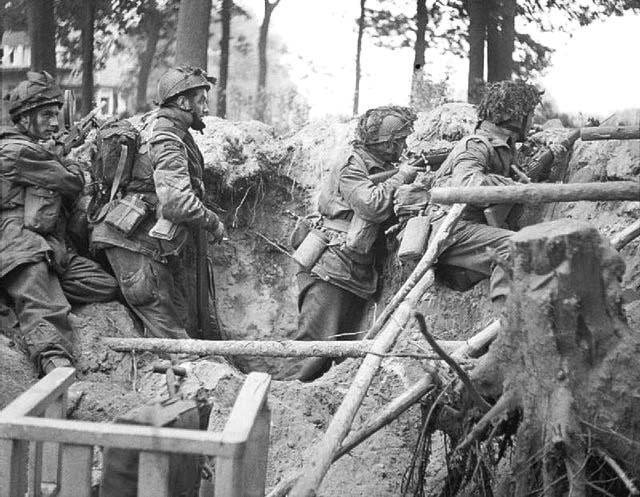Ferdy Belland
This week marks the 70th Anniversary of the infamous Operation Market Garden, one of the most humiliating defeats suffered by the Allies during the latter phases of the European Theatre of World War II.
Fought between 17-25 September 1944, Operation Market Garden was an over-ambitious plan hatched by British Field-Marshal Bernard Montgomery (aka "Monty") to punch a hole through German lines in the Nazi-occupied Netherlands, establish a bridgehead across the Rhine River via massive airborne paratrooper assaults, and drive headlong to Berlin along a seemingly open path, capturing Germany's vital Ruhr industrial centre en route.
It didn't happen that way.
Montgomery, ever the self-absorbed egotistical go-getter (on par with US General George Patton), had much reason to believe in the plan's success. Following the Allied invasion of Normandy ("D-Day;" 6 June 1944) and the breakout of the Normandy bridgehead, the combat-weary German panzergrenadier divisions were routed in the battle of the Falaise Pocket, which sent the shattered remnants of the Wehrmacht and the Waffen SS reeling out of France and back into the Low Countries.
Over-optimistic Allied intelligence assumed that Hitler, also losing alarming ground on both the Russian and Italian fronts, his industrial output disrupted by unstoppable Allied bombing campaigns, unable to supply his forces with adequate oil, ammunition, and reinforcements, would also be unable to regroup the Wehrmacht in Holland and stop Montgomery's promise: that the war would be over by Christmas 1944.
Montgomery did not reckon with the combined tactical genius of no less than three of Hitler's most brilliant commanders: Gerd von Rundstedt, admired by friend and foe alike for his quick cunning; Walther Model, nicknamed "Hitler's Fireman" for his counterattacking skills; and Kurt Student, grand architect of paratrooper concepts (proven with the Axis capture of Crete). All three men were rushed to Holland to collect the shattered Axis forces and anticipate Montgomery's next move. All three had spent the previous 18 months bitterly rethinking a vast war that had turned against Hitler, and learning to hold their ground with their backs to the wall, undermanned and undersupplied. And there they awaited the Allies.
Operation Market Garden's main objectives called for circumventing the German "Siegfried Line" defensive wall by a massive air-drop of over 40,000 British and American paratroopers, who would capture a series of strategic canal/river bridges around the Dutch cities of Arnhem, Nijmegen and Eindhoven; combined Allied armored and infantry divisions would then pierce deep into the Dutch countryside to the German border.
Despite initial successes after the first air-drops, the reorganized and re-disciplined Wehrmacht infantry battalions delivered devastating counter-blows which startled and surprised the Allied High Command; soon, the Allied airborne units were trapped within scattered, unconnected drop-zone pockets with seemingly no way out. After several days of vicious, confused fighting, the frustrated Montgomery grimly admitted that Market Garden was unviable, and ordered a tactical withdrawal of his 1st Airborne Division ... but how?
Enter the Canadians. The 20th & 23rd Field Company of the Royal Canadian Engineers (initially assigned within Market Garden's formations to capture the bridges and disarm potential German demolition attempts), the only British Commonwealth units trained in the use of the motorized stormboats used to cross the canals, braved murderous German fire to ferry trapped companies of the British 1st Airborne Division out of the failing drop-zone pockets. Major Michael Tucker and Lieutenant Russell Kennedy (both of whom commanded the withdrawal efforts) deserve as much remembrance for their efforts to salvage heroism from defeat — as much as Lt-Colonel John Frost (whose name adorns the Rhine bridge at Arnhem). British Empire thinking of the time (and that of Cornelius Ryan, author of "A Bridge Too Far") has downplayed (and downright ignored) the Canadian contribution to Operation Market Garden; had the Allied planning been better, it is certain the Canadian forces would have performed as outstanding as they did throughout autumn 1944 and beyond; Canadian troops are still admired today for their leading role in the liberation of the Netherlands (and the famine relief for the downtrodden Dutch civilians starving under Nazi rule).
The aftermath of Operation Market Garden (144 aircraft lost, 88 armored vehicles destroyed, and over 17,000 casualties — in five days) was solid, sober proof that the Nazis were far from beaten. This would be proven again in the weeks and months to come, with horrific fighting through the Huertgen Forest and the Ardennes Offensive (the "Battle of the Bulge"). Solid coordination between the Allied units took angry months to straighten out; not until March 1945 was the Rhine River finally crossed for real and the western drive into Nazi Germany begun in earnest. Due to the agonizing delay, the capture of Berlin went to the Russians, and the resulting post-war tensions between distrustful allies stained the world until the end of the 1980s.
The Canadians were there when the Allies went a bridge too far. Lest we forget.
